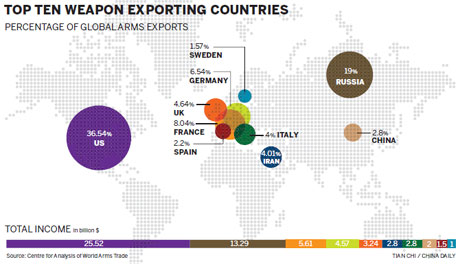
Experts say increase due to rising security risks around the world
Despite the gloomy world economy, Chinese observers have cast their sights to a prosperous global arms market, which has hit the post-Cold War peak in 2012 according to a Russian report issued earlier this month.
The seemingly abnormal situation, driven by complex factors including turmoil in the Middle East and big appetites of international arms dealers, is likely to cast a?shadow over the already troublesome situation in East Asia, they said.
According to the report Russia's Center for Analysis of World Arms Trade issued in early August, global military equipment exports are to hit $69.84 billion this year, the highest level since the end of the Cold War.

It is a 3.84 percent increase on the $67.26 billion in 2011, which was already nearly 20 percent higher than the $56.22 billion in 2010.
Increases in 2010 and 2011 were a result of weapon deals that had been delayed by the financial crisis that started in 2008, said the report.
Li Qinggong, deputy secretary of the China Council for National Security Policy Studies, said the recent surge is due to rising security risks around the world, especially turmoil in West Asia and North Africa, and escalating terrorism threats.
"Many countries, not only the ones in West Asia and North Africa, now feel more threatened. The traditional risks are still there, and new ones keeping emerging," Li said.
"Major weapon exporting nations are also trying to support the industry to stimulate the dim economy," he said.
Li said the trade had also benefited from countries worldwide updating their weapons.
Su Hao, an expert on political and security affairs with China Foreign Affairs University, noted escalating tensions in East Asia.
"Rising uncertainties in the region is also a contributing factor," he said.
Tensions on the rise
Tensions in the South China Sea have increased in recent months following a confrontation between China and the Philippines near China's Huangyan Island in April. The US and Japan have announced plans to help further equip the Philippine armed forces.
The Russian report said exports will hit $77.5 billion in 2015, after a slight drop in 2013 and 2014. The peak in 2015 is due to "huge contracts" signed between the United States and Saudi Arabia and other countries in the Near East, it said.
"Turmoil in the Middle East is likely to maintain and even escalate in the near future, so it is not hard to understand Saudi Arabia's need to better equip itself," Su said.
"In another view Western countries also need a strong Saudi Arabia and other regional powers to balance their traditional enemies such as Iran."
According to the report, Russia is the world's second-largest weapon supplier in 2012, with an export volume of $13.29 billion - 19 percent of the world market.
Russia had a good sales result, although it lost markets in Iran and Libya due to arms sanctions on the two nations and partly lost the Syrian market. It has also been crowded out of the market in Saudi Arabia by the US.
The Russian report showed France ranked third, with $5.61 billion in exports, a figure expected to rise to $19 billion by 2015.
France is followed by Germany, which has $4.57 billion in exports, the United Kingdom with $3.24 billion and Iran with $2.8 billion. Italy, China, Spain and Sweden rank successively after Iran.
Hu Siyuan, an expert with PLA Defense University, said China's weapon exports are second-class compared with the world's leading exporters, "especially in the fields of material and sensing technique".
Li Qinggong said China sells combat fighters to Pakistan and training jets to other countries.
Japan relaxed its self-imposed decades-old ban on military equipment exports in December 2011, and the Philippines became its first consumer.
Japan is not a big player in the world arms market, but it is now trying to have a finger in the pie to help boost the domestic economy, Li said.
"But Japan may not manage to achieve that goal, as Washington will not allow it to sell weapons based on technology mainly learned from the US," he added.
US leads market
The US leads the global arms market, with its export volume hitting $25.52 billion, or 36.53 percent of the global figure. Its status will further be consolidated in 2013, accounting for 40 percent of the world share.
Chen Fei, a scholar majoring in international issues at Zhongnan University of Economics and Law based in Central China's Hubei province, said on a TV program on Sunday the Obama administration's fanning of tensions in East Asia is partially driven by US arms dealers.
"Congressmen, political figures and arms dealers in the country have formed a close mutual interest community," he said.
Neither presidential candidate has talked about domestic gun control this year, as it has been deemed a "politically toxic" topic.
Chen said that under such a political environment, the Obama administration has to create a more favorable outside environment for arms dealers through moves including its high-profile strategic pivot to East Asia.
In late July, on the last day of a UN conference involving the 193 member nations aimed at forging a world regulation on weapon deals, Washington blocked efforts by insisting that all member nations should have veto rights on the document.
Contact the writers at lixiaokun@chinadaily.com.cn and zhouwa@chinadaily.com.cn